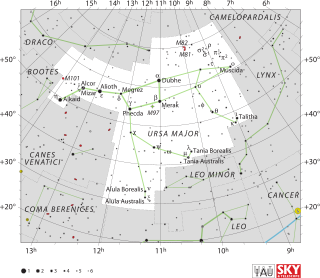| Observation data Epoch J2000.0 Equinox J2000.0 | |
|---|---|
| Constellation | Ursa Major |
| Right ascension | 09h 03m 37.52762s[1] |
| Declination | +47° 09′ 23.4890″[1] |
| Apparent magnitude (V) | 3.56 (4.16 + 4.54)[2] |
| Characteristics | |
| Spectral type | A0 IV-V + A0 V[3] |
| Astrometry | |
| Proper motion (μ) | RA: −36.19[1] mas/yr Dec.: −55.40[1] mas/yr |
| Parallax (π) | 9.10 ± 0.50 mas[1] |
| Distance | 360 ± 20 ly (110 ± 6 pc) |
| Absolute magnitude (MV) | −1.63[4] |
| Orbit[5] | |
| Period (P) | 13,007.2±9.7 d |
| Semi-major axis (a) | 0.18194 ± 0.00025″ |
| Eccentricity (e) | 0.5584±0.0015 |
| Inclination (i) | 109.410±0.066° |
| Longitude of the node (Ω) | 105.641±0.080° |
| Periastron epoch (T) | 50404 ± 12 |
| Argument of periastron (ω) (secondary) | 355.63±0.36° |
| Details | |
| κ UMa A | |
| Mass | 3.79±0.12[6] M☉ |
| Radius | 7.87[7] R☉ |
| Temperature | 9,060[7] K |
| Rotational velocity (v sin i) | 201[6] km/s |
| Other designations | |
| Database references | |
| SIMBAD | data |
Kappa Ursae Majoris (κ Ursae Majoris, abbreviated Kappa UMa, κ UMa) is a binary star in the constellation of Ursa Major. With a combined apparent magnitude of +3.60,[9] the system is approximately 358 light-years from Earth.
The two components are designated Kappa Ursae Majoris A (officially named Alkaphrah /ælˈkæfrə/, a traditional name of the system)[10] and B.
- ^ a b c d e Cite error: The named reference
aaa474_2_653was invoked but never defined (see the help page). - ^ Cite error: The named reference
mnras389_2_869was invoked but never defined (see the help page). - ^ Cite error: The named reference
aj81_245was invoked but never defined (see the help page). - ^ Cite error: The named reference
Anderson2012was invoked but never defined (see the help page). - ^ Cite error: The named reference
Hartkopf2006was invoked but never defined (see the help page). - ^ a b Cite error: The named reference
zorec2012was invoked but never defined (see the help page). - ^ a b Cite error: The named reference
Cotten2016was invoked but never defined (see the help page). - ^ Cite error: The named reference
SIMBADwas invoked but never defined (see the help page). - ^ Cite error: The named reference
clpl4was invoked but never defined (see the help page). - ^ "Naming Stars". IAU.org. Retrieved 16 December 2017.
